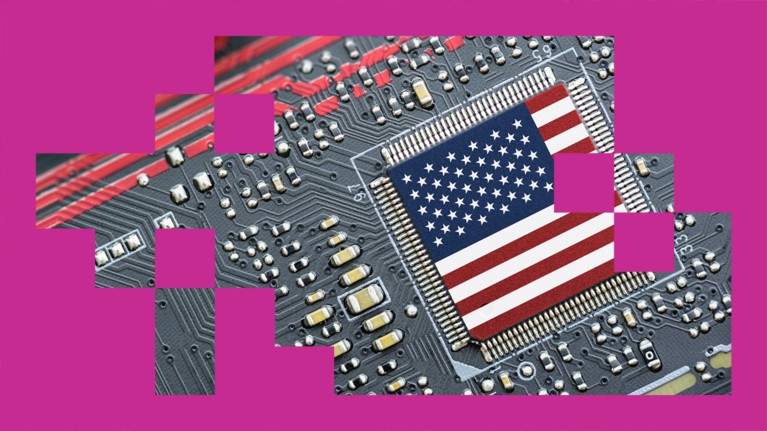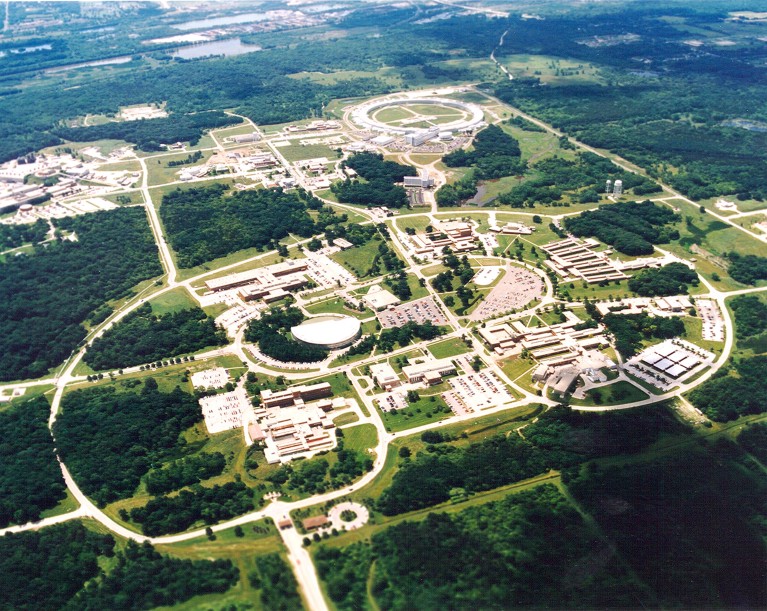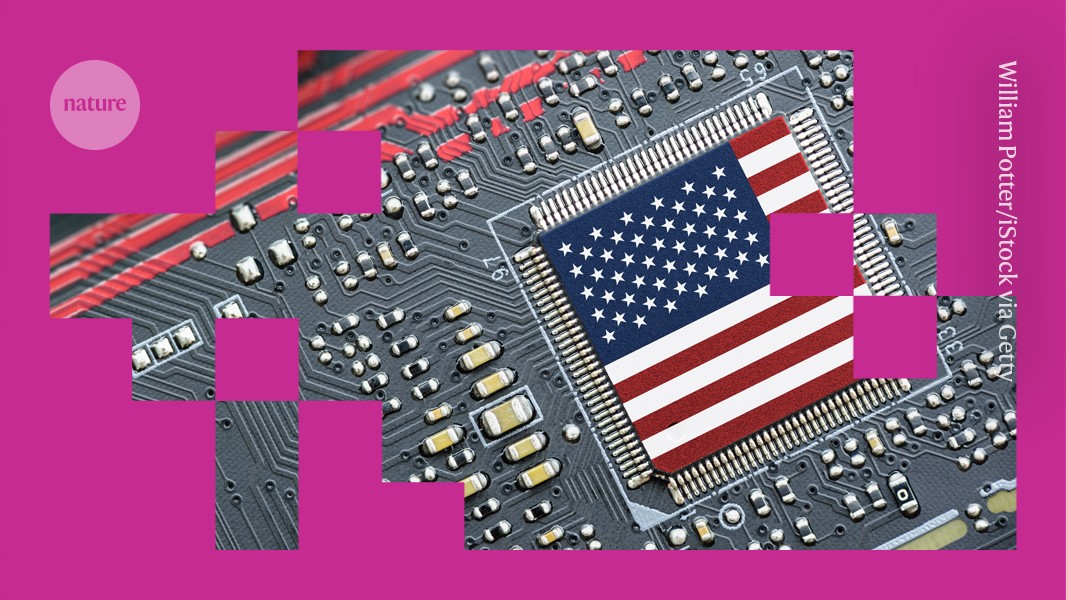
The Genesis Mission aims to provide researchers with the computing power and data sets necessary to train artificial-intelligence models.Credit: William Potter/iStock via Getty
The White House has launched a plan to accelerate research in the United States, by building artificial intelligence (AI) models on the rich scientific data sets held by the country’s 17 national laboratories, as well as harnessing their enormous computing resources.
An executive order issued on 24 November instructs the US Department of Energy (DoE) to create a platform through which academic researchers and AI firms can create powerful AI models using the government’s scientific data. Framed as part of a race for global technology dominance, it lists collaborations with technology firms including Microsoft, IBM, OpenAI, Google and Anthropic, as well as quantum-computing companies such as Quantinuum. Such a vast public–private partnership would give companies unprecedented access to federal scientific data sets for AI-driven analysis.
The effort, dubbed the Genesis Mission, aims to “double the productivity and impact of American research and innovation within a decade”, in a variety of fields from fusion energy to medicine. The project expects to “unlock breakthroughs in medicine, energy, materials science, and beyond”, says Michael Kratsios, the US president’s science adviser. It also aims to build AI agents — general models with the ability to harness tools such as specialized software and coding suites — that can generate hypotheses and automate research workflows.
Labs around the world are already training AI systems on scientific data, to boost their capabilities in scientific domains and attempting to use AI models to make discoveries. But some researchers remain sceptical that general AI tools are capable of making truly fresh insights, and warn that their inherent flaws make the value of agents unclear.
The new US initiative formalizes and expands ongoing AI research efforts by the administration of President Donald Trump. “The impact is that it enables many more scientists and researchers to have access to all of the infrastructure that they need to explore important scientific questions that the country cares about,” says Lynne Parker, a robotics engineer at the University of Tennessee, Knoxville, and who led AI-policy initiatives for the administrations of Trump and his predecessor, Joe Biden, but was not involved in the current initiative. “That really has not been possible before.”

Supercomputers at national laboratories, including the Argonne National Laboratory in Illinois, will probably be used as part of the Genesis Mission.Credit: Argonne National Laboratory/Getty
Trump’s team has been working to funnel money and attention to AI projects even as it tries to gut federal research spending more broadly. The White House has the power to shape the direction of research at the DoE’s network of national laboratories. It did not give an estimated price tag for the AI initiative; any extra funding beyond the laboratories’ normal budgets would have to be approved by the US Congress.
Nature looks at how the project might affect researchers and AI companies, and its promises and risks.
What are government-funded scientists being asked to do?
The scale and timeline of the plan is ambitious. In 60 days, the DoE is expected to create a list of 20 potential science and technology challenges for the project to tackle, in areas of national priorities such as nuclear fusion, quantum information science and crucial materials. The agency is supposed to create a full inventory of available federal computing resources and identify initial data assets to use, then work out how to safely include external data sets. The administration expects to demonstrate the platform’s capability for one of these research challenges in nine months.
These early steps will probably build on projects that are already under way at the national laboratories. For instance, Oak Ridge National Laboratory in Tennessee has been working on advancing AI research using a hybrid approach that uses both quantum and classical computing. Lawrence Berkeley National Laboratory in California is using AI to find ways to speed up network traffic.
How AI agents will change research: a scientist’s guide
The “DoE has been making a case for ‘AI for science’ for over seven years, and this executive order is the starting pistol to get on with it”, says Michael Norman, an astrophysicist at the University of California San Diego and former director of the San Diego Supercomputer Center. “It is an exciting direction indeed.”
What are companies being asked to do?
The project has named more than 50 collaborating companies, including some that have already been working on their own ‘AI scientists’. FutureHouse, a start-up based in San Francisco, California, for instance, launched a commercially available, AI-driven research platform earlier this month.
The precise role of these private companies in the Genesis plan remains unclear — although Trump’s executive order says the project will entail “collaboration with external partners possessing advanced AI, data, or computing capabilities or scientific domain expertise”. Such partnerships could include research agreements to jointly develop technologies, or a user-facility agreement for external researchers to conduct work in government facilities. Chip-manufacturing and computer companies such as NVIDIA, Advanced Micro Devices and Hewlett Packard Enterprise have reportedly agreed to build facilities in national labs, according to a report by The New York Times.
Three ways ex-CDC chief says that Trump team is sidelining science
Some partnerships are already under way. In October, for instance, Argonne National Laboratory in Illinois announced a partnership with NVIDIA and technology firm Oracle to build two next-generation AI supercomputing systems. At least two national laboratories already have arrangements with the company OpenAI, based in San Francisco, California, to host local AI models that can process classified data on computers in the facilities. In February, the company held an ‘AI jam session’ with researchers from nine US national labs that allowed scientists to test the use of OpenAI’s reasoning models in their specific domains.
What are the opportunities?
The new Genesis Mission is meant to provide “secure access to appropriate datasets, including proprietary, federally curated, and open scientific datasets, in addition to synthetic data generated through DOE computing resources”, according to the executive order. Creating a national-scale platform that harnesses rich data sets usually housed in the walls of the national laboratories could be a boon for researchers. Although task-specific models such as the protein-folding model AlphaFold were built on open scientific data sets, general-purpose AI systems such as OpenAI’s GPT-5 are thought to be largely built on data scraped from the Internet.
It isn’t yet clear which data sets would be involved, but possible candidates include information gathered at facilities such as the Spallation Neutron Source at Oak Ridge National Laboratory. That facility collects neutron-scattering data, which illuminate how materials behave at the atomic scale, says Georgia Tourassi, the lab’s associate director for computing and computational sciences. “From atomistic measurements to exascale simulations, such data sets can immediately accelerate the development of trustworthy, science-capable AI models,” she says.




